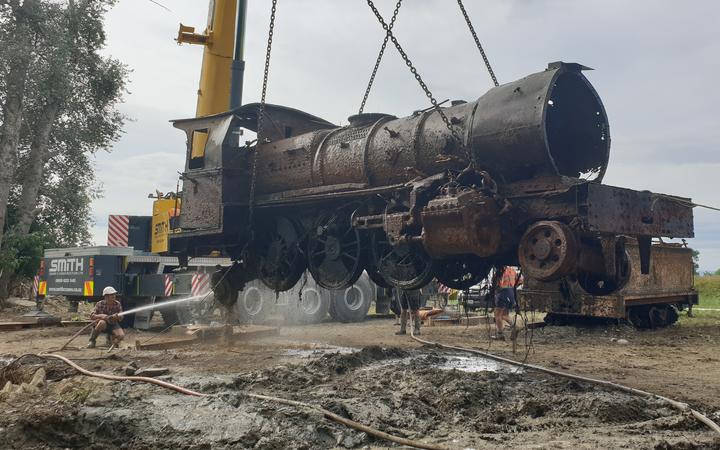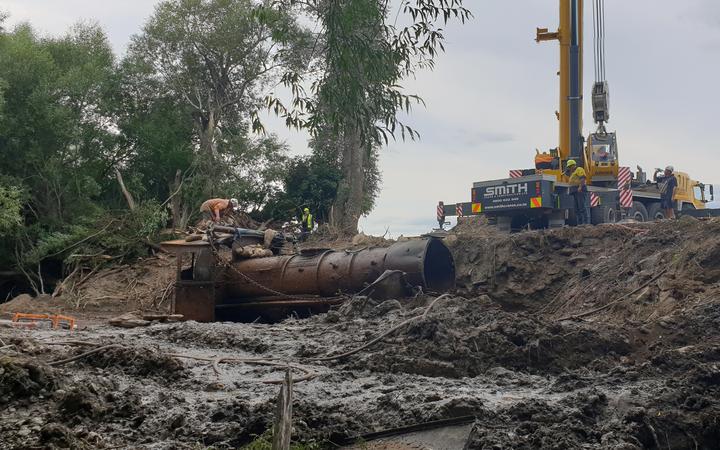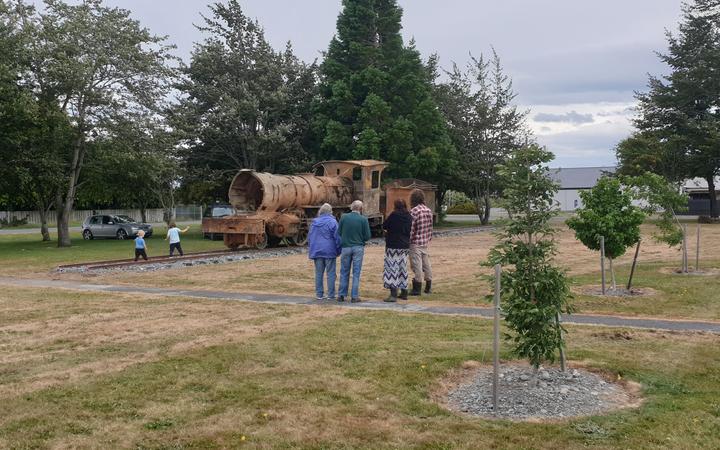
Lumsden hoists 1885 V-class locomotive from tonnes of river muck
A relic of New Zealand's rail past has emerged from the mud 93 years after being dumped in a Southland River.

The V class locomotive is hoisted from the river at last. Photo: RNZ / Tess Brunton
A crowd gathered today as the recovered locomotive was placed in front of the Lumsden Railway Precinct - a tribute to a bygone era.
The Lumsden Heritage Trust has been campaigning to retrieve the two 1885 V class steam locomotives from the Oreti River for about half a decade.
Retrieving the machines - thought to be one of the last of their kind in the world - was no easy task.
It was full steam ahead on Wednesday morning, with water pumps on and a crane poised above the first locomotive, which first hit New Zealand tracks back in 1885.
Recovery teams tried hoisting it, but the locomotive was too heavy to lift.
Walking around the muddy riverbank surrounded by willow trees, site safety supervisor Russell Bradley explained that tonnes of mud had lodged in the locomotive, weighing it down.
Workers blasted it with water and hacked at a thick weave of willow roots covering the machine with a garden hoe.
Lumsden Heritage Trust chair John Titter said they were lucky they could even attempt a recovery.
In the wake of the First World War, the value of scrap metal was low so instead of being sold locomotives were dumped in rivers around the country to act as flood barriers.

New Zealand Rail's V-Class locomotive no. 126, in 1892. Photo: Supplied/ E.J. McClaire Collection
"Even the guys when we were digging out the other day were jumping up and down because the running boards were there. When we moved it the other day, the wheels turned which is incredible," Titter said.
This was the last opportunity to retrieve the locomotives - the consents are about to roll over and the landowner wanted to see action, he said.
The trust fundraised about a third of the $158,000 cost, before securing the rest of the funding from other organisations.
They had wanted to recover both machines, but Titter said it wasn't to be.
"Over the last couple of days, it's actually gone from a massive task to a mammoth task."
Suction was one of the challenges the workers faced.

The locomotives were filled with tonnes of silt and river muck, so hauling them out required a huge effort. Photo: RNZ / Tess Brunton
"The tender itself weighs 22 tonnes, he was pulling over 30 tonne trying to get it out. The locomotive is 32 tonne sitting on the track. We believe there's probably another 10 tonne of silt in the boilers and things like that," Titter said.
There was relief as the locomotive was hoisted into the air - Titter said it was an unbelievable experience - and emotions ran high as it was placed down onto the back of a transport truck.
"When they lighten these things up for New Zealand rail they weaken the frames and so it's been sitting in my mind that the frame could snap in half at any time ... But there it sits so far, getting on a transport and into town. I think we're nearly there," Titter said.
Southland District Councillor Rob Scott said it was a remarkable effort.
"We were made aware of it, thought it was of an old wives' tale that there was a train buried down here. We came and had a look early on.
"It looked like a mammoth project and it has been a mammoth project - but when you look at the operators we've got, it's a great network of really, really talented people."

One of the 1885 V class locomotives has been set up in front of the Lumsden Railway Precinct. Photo: RNZ / Tess Brunton
"They've pulled off something that was pretty impressive."
For Bradley, it was a once-in-a-lifetime opportunity. He said it would be a reminder of the massive task every time he drove past the locomotive and would be a story he could tell and show his grandchildren.
As for the second locomotive, Bradley said that would be up to the next generation to recover from the soon-to-be restored riverbank.
Second locomotive buried in river bed has been recovered
After initially deeming the recovery unfeasible, the Lumsden Heritage Trust has lifted the second locomotive from its watery bed.
In January, one of two 1885 V class locomotives stuck in the Oreti River near Lumsden, Southland, for the past 97 years was retrieved and put on display. At the time, recovering the second one was deemed too hard.
Trust chairman John Titter said due to the interest shown, and what had been learned from pulling out the first train, it was worth an attempt to pull out the second.
The issue that made the second locomotive more difficult was that it was further away from the river bank and would put more pressure on the crane lifting it, Titter said.
READ MORE:
* Recovered locomotive more than just a huge ornament
* Rare locomotive pulled from river bank in Northern Southland
* Trust making progress in retrieving locomotives from Oreti River
They came up with the idea of using a winch to move the locomotive closer to the river banks so it could be safely pulled, he said.
The second one was sitting on gravel so when they were able to lift it, it came out a lot easier than the first, he said.
The two locomotives were similar engines but were in different condition, he said.
On the second locomotive, the exhaust system was still intact however was missing part of its roof.
New Zealand Railways tipped the two locomotives into the Oreti River in 1927 for flood protection, after they were deemed as surplus stock and because the price of scrap metal was low after the war.
Since the first locomotive was lifted and put on display in Lumsden, it had become a tourist attraction for steam enthusiasts from around the world, Titter said.
There was a British man who had taken a cruise ship to Dunedin but when he heard about the locomotive, he hired a rental car and spent a day in Lumsden with his wife to look at it, he said.
The trust had also been contacted by steam enthusiast magazines in Britain to come down to Lumsden and take photos of the old train, he said.
Work on retrieving the second locomotive began on Wednesday.






No comments:
Post a Comment